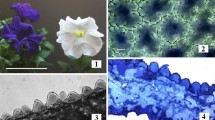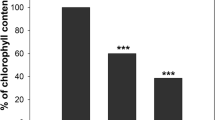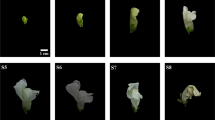Abstract
Main conclusion
Different autophagy pathways are a driver of vacuolar biogenesis and are development stage specific during the extrafloral nectary development in Citharexylum myrianthum.
Abstract
Plant autophagy plays an important role in various developmental processes such as seed germination, pollen maturation and leaf senescence. However, studies that address the evidence of autophagy and its role in the development of plant glands are scarce and largely restricted to laticifers. Regarding nectary, studies have repeatedly pointed to signs of degradation associated with the end of the secretory cycle, without exploring autophagy. Likewise, the relationship between autophagy and biogenesis of vacuoles remains an unexplored issue. In this study, using conventional and microwave fixation in association with ultracytochemical methods for transmission electron microscopy, we investigated the occurrence of autophagy and its implication in the differentiation of extrafloral nectary in Citharexylum myrianthum (Verbenaceae) under natural conditions, focusing on the vacuole biogenesis. We described a variety of vacuole types associated with the stage of nectary epidermis development, which differs with respect to origin, function and nature of the products to be stored. Three distinct autophagy pathways were detected: macroautophagy, microautophagy (both restricted to the undifferentiated epidermal cells, at the presecretory stage) and megaautophagy (circumscribed to the differentiated epidermal cells, at the postsecretory stage). Our study clearly demonstrated that the vacuole variety and autophagy processes in the nectary epidermal cells are development specific. This study highlights the role of autophagy in vacuole biogenesis and its implications for the development of nectary and opens new venues for future studies on regulation mechanisms for autophagy in plant secretory structures under normal conditions.







Similar content being viewed by others
Abbreviations
- AcPase:
-
Acid phosphatase activity
- EFN:
-
Extrafloral nectaries
- MVB:
-
Multivesicular bodies
- PAS:
-
Periodic acid/Schiff reagent
- RER:
-
Rough endoplasmic reticulum
- SER:
-
Smooth endoplasmic reticulum
- TEM:
-
Transmission electron microscopy
- ZIO:
-
Zinc iodide–osmium tetroxide
References
Alberts B, Johnson A, Lewis J, Raff M, Roberts K, Walter P (2002) Molecular biology of the cell. 4th edn. Garland Science, New York
Bassham DC, Crespo JL (2014) Autophagy in plants and algae. Front Plant Sci 5:679
Bassham DC, Laporte M, Marty F, Moriyasu Y, Ohsumi Y, Olsen LJ, Yoshimoto K (2006) Autophagy in development and stress responses of plants. Autophagy 2:2–11
Bethke PC, Swanson SJ, Hillmer S, Jones RL (1998) From storage compartment to lytic organelle: the metamorphosis of the aleurone protein storage vacuole. Ann Bot 82:399–412
Bozhkov PV (2018) Plant autophagy: mechanisms and functions. J Exp Bot 69:1281–1285
Cai X, Li W, Yin L (2009) Ultrastructure and cytochemical localization of acid phosphatase of laticifers in Euphorbia kansui Liou. Protoplasma 238:3–10
Charriére-Ladreix Y (1975) La sécrétion lipophile des bourgeons d’Aesculus hippocastanum L.: modifications ultrastructurales des trichomes au cours du processus glandulaire. J Microsc Biol Cell 24:75–90
Duff SMG, Sarath G, Plaxton WC (1994) The role of acid phosphatase in plant phosphorus metabolism. Physiol Plant 90:791–800
Evert RF (2006) Esau’s plant anatomy: meristems, cells, and tissues of the plant body-their structure, function, and development, 3rd edn. Wiley, Hoboken
Fahn A (1979) Secretory tissues in plant. Academic Press, London
Gaffal PK, Friedrichs GJ, El-Gammal S (2007) Ultrastructural evidence for a dual function of the phloem and programmed cell death in the floral nectary of Digitalis purpurea. Ann Bot 99:593–607
Giordani R (1978) Autophagie cellularie et différenciation des laticifères non articulés chez une Asclépiade. Biol Cell 33:253–260
Guimarães E, Nogueira A, Machado SR (2016) Floral nectar production and nectary structure of a bee-pollinated shrub from Neotropical savanna. Plant Biol 18:26–36
Guimarães E, Tunes P, Almeida Junior LD, Di Stasi LC, Dötter S, Machado SR (2018) Nectar replaced by volatile secretion: a potential new role for nectarless flowers in a bee-pollinated plant species. Front Plant Sci 9:1243
Harborne JB (1997) Plant secondary metabolism. In: Crawley MJ (ed) Plant ecology. Blackwell, Berlin, pp 132–155
Hasegawa Y, Lynn KR, Brockbank WJ (1976) Isolation and partial characterization of cytoplasmic and wall-bound acid phosphatase from wheat roots. Can J Bot 54:1163–1169
Hauser MT, Wink M (1990) Uptake of alkaloids by latex vesicles and isolated mesophyll vacuoles of Chelidonium majus (Papaveraceae). Z Naturforsch 45c:949–957
Jensen WA (1962) Botanical histochemistry: principles and practice. W.H. Freeman & Co., San Francisco
Kwon SI, Cho HJ, Jung JH, Yoshimoto K, Shirasu K, Park OK (2010) The Rab GTPase RabG3b functions in autophagy and contributes to tracheary element differentiation in Arabidopsis. Plant J 64:151–164
Lamb CA, Yoshimori T, Tooze SA (2013) The autophagosome: origins unknown, biogenesis complex. Nat Rev Mol Cell Biol 14(12):759–774
Li F, Vierstra RD (2012) Autophagy: a multifaceted intracellular system for bulk and selective recycling. Trends Plant Sci 17(9):526–537
Liu Y, Bassham DC (2012) Autophagy: pathways for self-eating in plant cells. Annu Rev Plant Biol 63:215–237
Machado SR, Souza CV, Guimarães E (2017) A reduced, yet functional, nectary disk integrates a complex system of floral nectar secretion in the genus Zeyheria (Bignoniaceae). Acta Bot Bras 31:344–357
Machado SR, Gregório EA, Rodrigues TM (2018) Structural associations between organelle membranes in nectary parenchyma cells. Planta 247:1067–1076
Marty F (1978) Cytochemical studies on GERL, provacuoles and vacuoles in root meristematic cells of Euphorbia. Proc Natl Acad Sci USA 75:852–856
Matile P (1984) Das toxische Kompartment der Pflanzenzelle. Naturwiss 71:18–24
Meirelles MNL (1998) Localizacão de fosfatases. In: Souza W (ed) Técnicas básicas de microscopia eletrônica aplicadas às ciências biológicas. Sociedade Brasileira de Microscopia, Rio de Janeiro, pp 84–93
Michaeli S, Avin-Wittenberg T, Galili G (2014) Involvement of autophagy in the direct ER to vacuole protein trafficking route in plants. Front Plant Sci 5:134
Mitou G, Budak H, Gozuacik D (2009) Techniques to study autophagy in plants. Int J Genom 2:451357
Mizushima N, Komatsu M (2011) Autophagy: renovation of cells and tissues. Cell 147:728–741
Mizushima N, Yoshimori T, Ohsumi Y (2011) The role of Atg proteins in autophagosome formation. Annu Rev Cell Dev Biol 27:107–132
Mosti S, Friedman CR, Pacini E, Brighigna L, Papini A (2013) Nectary ultrastructure and secretory modes in three species of Tillandsia (Bromeliaceae) that have different pollinators. Botany 91:786–798
Nadal M, Gold SE (2012) Assessment of autophagosome formation by transmission electron microscopy. Methods Mol Biol 835:481–489
Nepi M (2007) Nectary structure and ultrastructure. In: Nicolson SW, Nepi M, Pacini E (eds) Nectaries and nectar. Springer, Dordrecht, pp 129–166
Paiva EAS, Machado SR (2008) The floral nectary of Hymenaea stigonocarpa (Fabaceae, Caesalpinioideae): structural aspects during floral development. Ann Bot 101:125–133
Papini A, Mosti S, Milocani E, Tani G, Di Falco P, Brighigna L (2011) Megasporogenesis and programmed cell death in Tillandsia (Bromeliaceae). Protoplasma 248:651–662
Petanidou T (2007) Ecological and evolutionary aspects of floral nectars in Mediterranean habitats. In: Nicolson SW, Nepi M, Pacini E (eds) Nectaries and nectar. Springer, Dordrecht, pp 343–375
Pino RM, Pino LC, Bankston PW (1981) The relationships between the Golgi apparatus, GERL, and lysosomes of fetal rat liver kupffer cells examined by ultrastructural phosphatase cytochemistry. J Histochem Cytochem 29:1061–1070
Piper RC, Katzmann DJ (2010) Biogenesis and function of multivesicular bodies. Annu Rev Cell Dev Biol 23:519–547
Reinecke M, Walther C (1978) Aspects of turnover and biogenesis of synaptic vesicles at locust neuromuscular junctions as reveled by iodide-osmium tetroxide (ZIO) reacting with intravesicular sh-groups. J Cell Biol 21:839–855
Reyes FC, Chung T, Holding D, Jung R, Vierstra R, Otegui MS (2011) Delivery of prolamins to the protein storage vacuole in maize aleurone cells. Plant Cell 23:769–784
Reynolds ES (1963) The use of lead citrate at high pH as an electron opaque stain in electron microscopy. J Cell Biol 17:208–212
Robinson DG, Hinz G (1997) Vacuole biogenesis and protein transport to the plant vacuole: a comparison with the yeast vacuole and the mammalian lysosome. Protoplasma 197:1–25
Roshchina VV, Roshchina VD (1993) The excretory function of higher plants. Springer, Berlin
Rubinsztein DC, Shpilka T, Elazar Z (2012) Mechanisms of autophagosome biogenesis. Curr Biol 22:29–34
Soto-Burgos J, Zhuang X, Jiang L, Bassham DC (2018) Dynamics of autophagosome formation. Plant Physiol 176:219–229
Taboga SR, Vilamaior PSL (2007) Métodos de estudo da célula. Citoquímica. In: Carvalho HF, Recco-Pimentel SM (eds) A célula, 2nd edn. Manole, Barueri, pp 42–50
van Doorn WG, Papini A (2013) Ultrastructure of autophagy in plant cells; a review. Autophagy 9:1922–1936
Viotti C, Krüger F, Krebs M, Neubert C, Fink F, Lupanga U, Scheuring D, Boutté Y, Frescatada-Rosa M, Wolfenstetter S, Sauer N, Hillmer S, Grebe M, Schumacher K (2013) The endoplasmic reticulum is the main membrane source for biogenesis of the lytic vacuole in Arabidopsis. Plant Cell 25:3434–3449
Wang P, Mugume Y, Bassham DC (2017) New advances in autophagy in plants-regulation, selectivity and function. Semin Cell Dev Biol 80:113–122
Wink M (1993) Plant vacuole—a multifunctional compartment. J Exp Bot 44:231–246 (Suppl.)
Woodman PG, Futter CE (2008) Multivesicular bodies: co-ordinated progression to maturity. Curr Opin Cell Biol 20:408–414
Yang X, Bassham DC (2015) New insight into the mechanism and function of autophagy in plant cells. Int Rev Cell Mol Biol 320:1–40
Yin Z, Pascual C, Klionsky DJ (2016) Autophagy: machinery and regulation. Microb Cell 3(12):588–596
Yoshimoto K (2012) Beginning to understand autophagy, an intracellular self-degradation system in plants. Plant Cell Physiol 53:1355–1365
Yoshimoto K, Shibata M, Kondo M, Oikawa K, Sato M, Toyooka K, Shirasu K, Nishimura M, Ohsumi Y (2014) Organ-specific quality control of plant peroxisomes is mediated by autophagy. J Cell Sci 127:1161–1168
Zhang Q, Wang D, Zhang H, Wang M, Li P, Fang X, Cai X (2018) Detection of autophagy processes during the development of nonarticulated laticifers in Euphorbia kansui Liou. Planta 247:845–861
Zheng X, Zhao C, Liu Y (2018) Examining autophagy in plant by transmission electron microscopy (TEM). Bio-protocol 8(20):e3047
Zhu J, Hu ZH (2002) Cytological studies on the development of sieve element and floral nectary tissue in Arabidopsis thaliana. Acta Bot Sin 44:9–14
Acknowledgements
This work was supported by the ‘Conselho Nacional de Desenvolvimento Científico e Tecnológico’—CNPq (Grant to S.R. Machado Proc. 02657/2011-8 and to T.M. Rodrigues Proc. 303981/2018-0). We thank the staff of the Electron Microscopy Center of the São Paulo State University (UNESP), Institute of Biosciences, Campus of Botucatu (IBB), for the assistance with sample preparation.
Author information
Authors and Affiliations
Corresponding author
Ethics declarations
Conflict of interest
The authors declare that the research was conducted in the absence of any conflict of interest.
Additional information
Publisher's Note
Springer Nature remains neutral with regard to jurisdictional claims in published maps and institutional affiliations.
Rights and permissions
About this article
Cite this article
Machado, S.R., Rodrigues, T.M. Autophagy and vacuolar biogenesis during the nectary development. Planta 250, 519–533 (2019). https://doi.org/10.1007/s00425-019-03190-7
Received:
Accepted:
Published:
Issue Date:
DOI: https://doi.org/10.1007/s00425-019-03190-7




